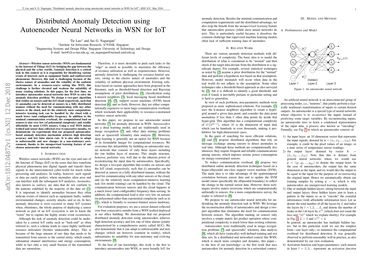Distributed Anomaly Detection using Autoencoder Neural Networks in WSN for IoT
Wireless sensor networks (WSN) are fundamental to the Internet of Things (IoT) by bridging the gap between the physical and the cyber worlds. Anomaly detection is a critical task in this context as it is responsible for identifying various events of interests such as equipment faults and undiscovered phenomena. However, this task is challenging because of the elusive nature of anomalies and the volatility of the ambient environments. In a resource-scarce setting like WSN, this challenge is further elevated and weakens the suitability of many existing solutions. In this paper, for the first time, we introduce autoencoder neural networks into WSN to solve the anomaly detection problem. We design a two-part algorithm that resides on sensors and the IoT cloud respectively, such that (i) anomalies can be detected at sensors in a fully distributed manner without the need for communicating with any other sensors or the cloud, and (ii) the relatively more computation-intensive learning task can be handled by the cloud with a much lower (and configurable) frequency. In addition to the minimal communication overhead, the computational load on sensors is also very low (of polynomial complexity) and readily affordable by most COTS sensors. Using a real WSN indoor testbed and sensor data collected over 4 consecutive months, we demonstrate via experiments that our proposed autoencoder-based anomaly detection mechanism achieves high detection accuracy and low false alarm rate. It is also able to adapt to unforeseeable and new changes in a non-stationary environment, thanks to the unsupervised learning feature of our chosen autoencoder neural networks.
PDF Abstract
